一、前情回顾
根据数据清洗确定排序列表不重复性元素,采用了如下案例
python
# coding=utf-8
### 有关清理数据的函数(数据清洗)
def santize(time_string):
if '-' in time_string:
spliter='-'
elif ':' in time_string:
spliter=':'
else:
return time_string
minutes,seconds=time_string.split(spliter)
return(minutes+'.'+seconds)
def get_coach_data(filename):
try:
with open(filename) as f:
data = f.readline()
return data.strip().split(',')
except IOError as error:
print('File error:'+str(error))
return (None)
sarch=get_coach_data('sarah.txt')
sarch_name,sarch_dob=sarch.pop(0),sarch.pop(0)
print(sarch_name+"'s fasterst times are"+str(sorted(set([santize(t) for t in sarch]))[0:3]))二、数据类型之字典表示
使用字典时,键对于字典来说无非就是唯一的
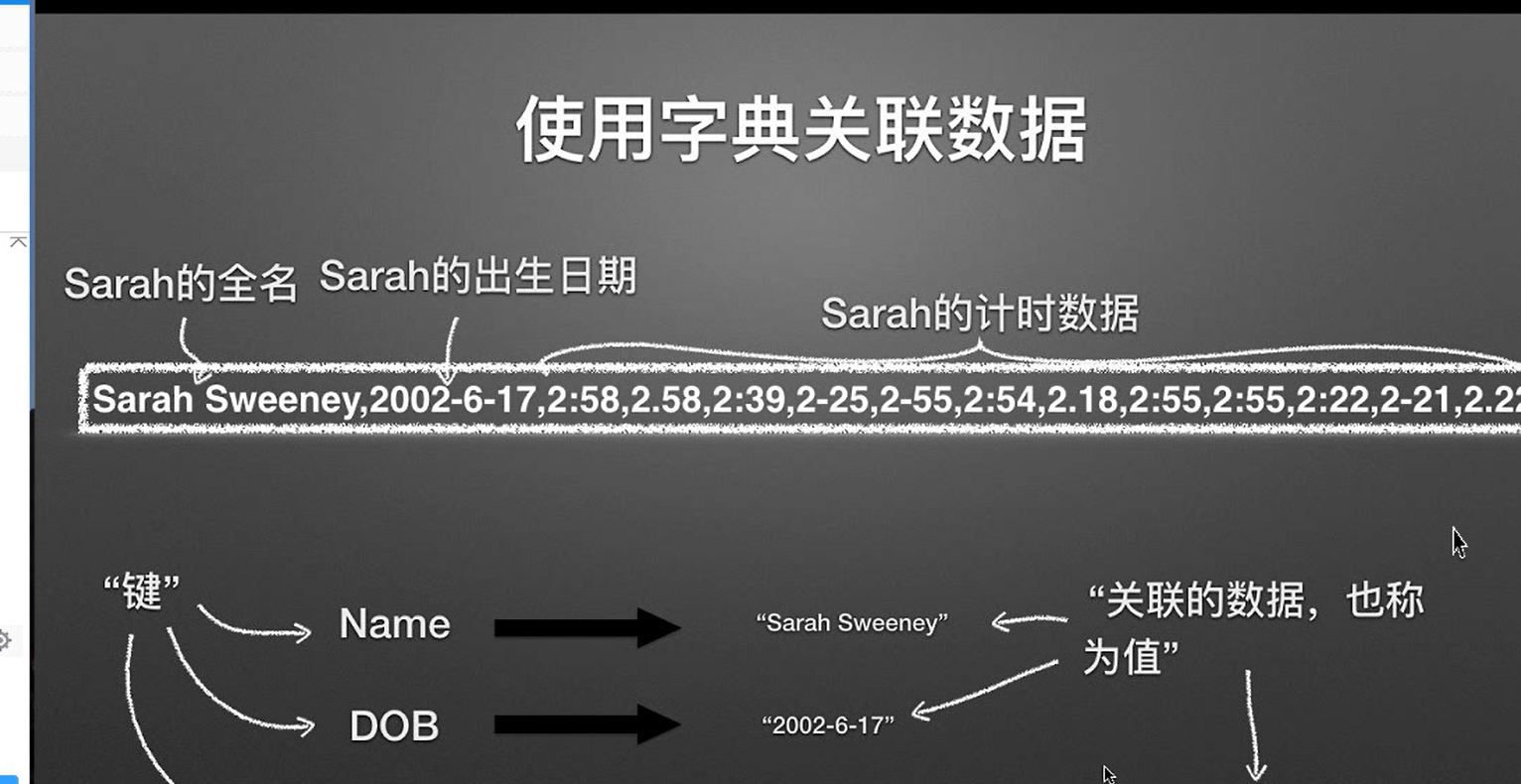
vbscript
>> num={}
>> num=dict()
>> num
{}
>> type(num)
<class 'dict'>
>> num['one']=1
>> num['two']=2
>> num
{'one': 1, 'two': 2}
>> num['one']
1
>> num['two']
2
>> num['nums']=[1,2,3,4,5,6]
>> num
{'one': 1, 'two': 2, 'nums': [1, 2, 3, 4, 5, 6]}
>> num['nums'][0]
1
>> num['nums'][-1]
6优前情回顾内容:
python
def get_coach_data(filename):
try:
with open(filename) as f:
data = f.readline()
return data.strip().split(',')
except IOError as error:
print('File error:'+str(error))
return (None)
sarch=get_coach_data('sarah.txt')
sarch_data={}
sarch_data['name']=sarch.pop(0)
sarch_data['dob']=sarch.pop(0)
sarch_data['times']=sarch
print(sarch_data['name']+"'s fastest time are:'"+str(sorted(set(santize(t) for t in sarch_data['times']))[0:3]))优化字典作为返回值,重写代码:
python
def santize(time_string):
if '-' in time_string:
spliter='-'
elif ':' in time_string:
spliter=':'
else:
return time_string
minutes,seconds=time_string.split(spliter)
return(minutes+'.'+seconds)
def get_coach_data(filename):
try:
with open(filename) as f
data = f.readline()
templ=data.strip().split(',')
#####修改部分代码#####
return({
'name':templ.pop(0),
'dob':templ.pop(0),
'times':str(sorted(set(santize(t) for t in templ))[0:3])
})
except IOError as error:
print('File error:'+str(error))
return (None)
james=get_coach_data('james.txt')
sarch=get_coach_data('sarah.txt')
print(james['name']+"'s fastest time are:'"+james['times'])
print(sarch['name']+"'s fastest time are:'"+sarch['times'])三、将对象打包到类中
- 定义一个类
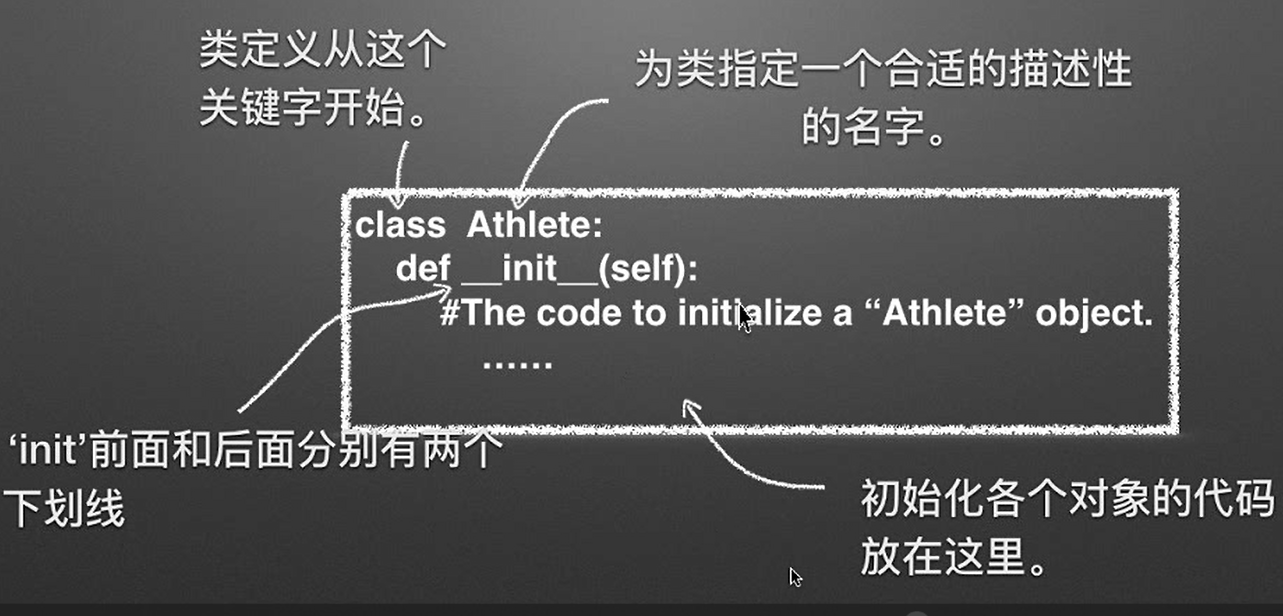
- 类的定义图解
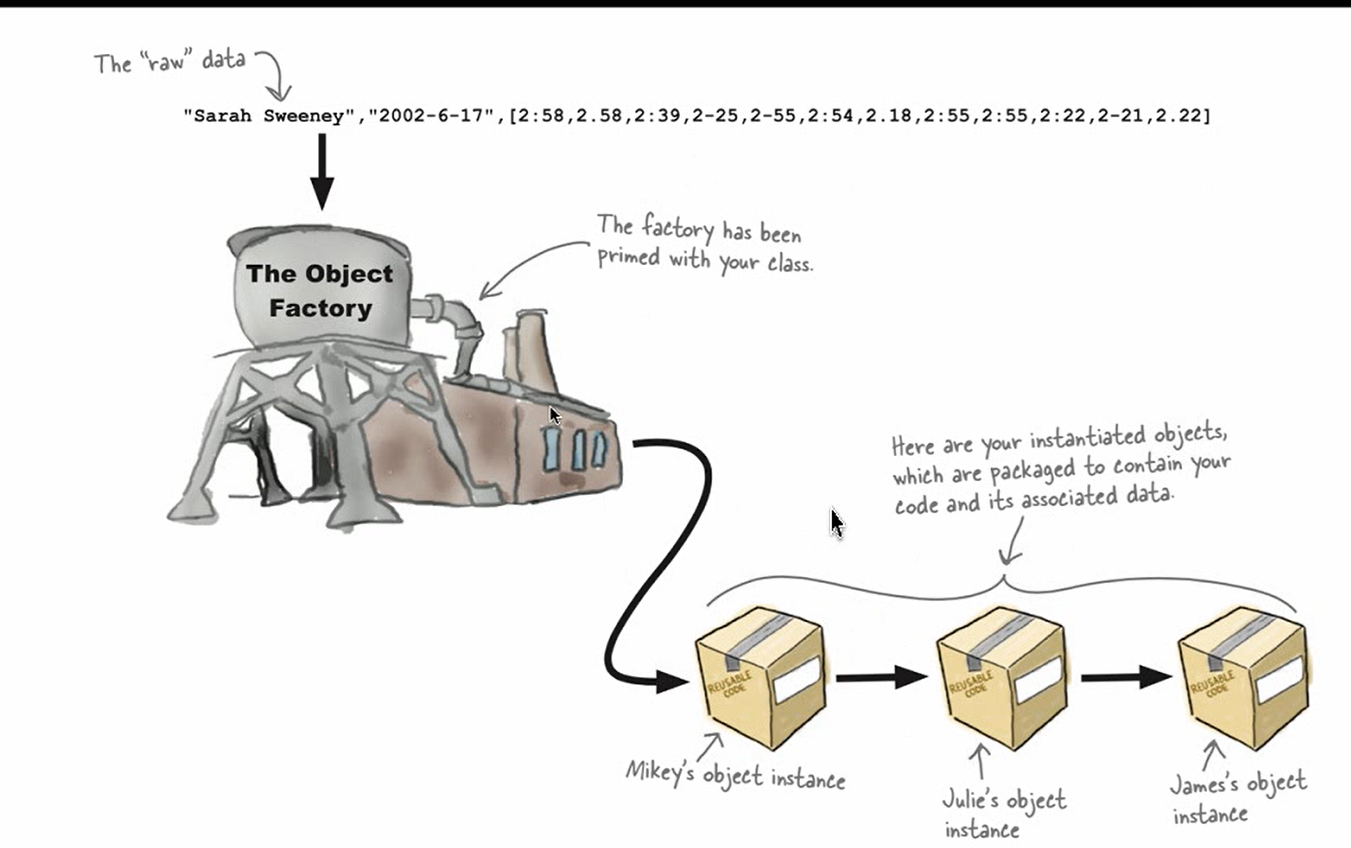
- 类的对象实例
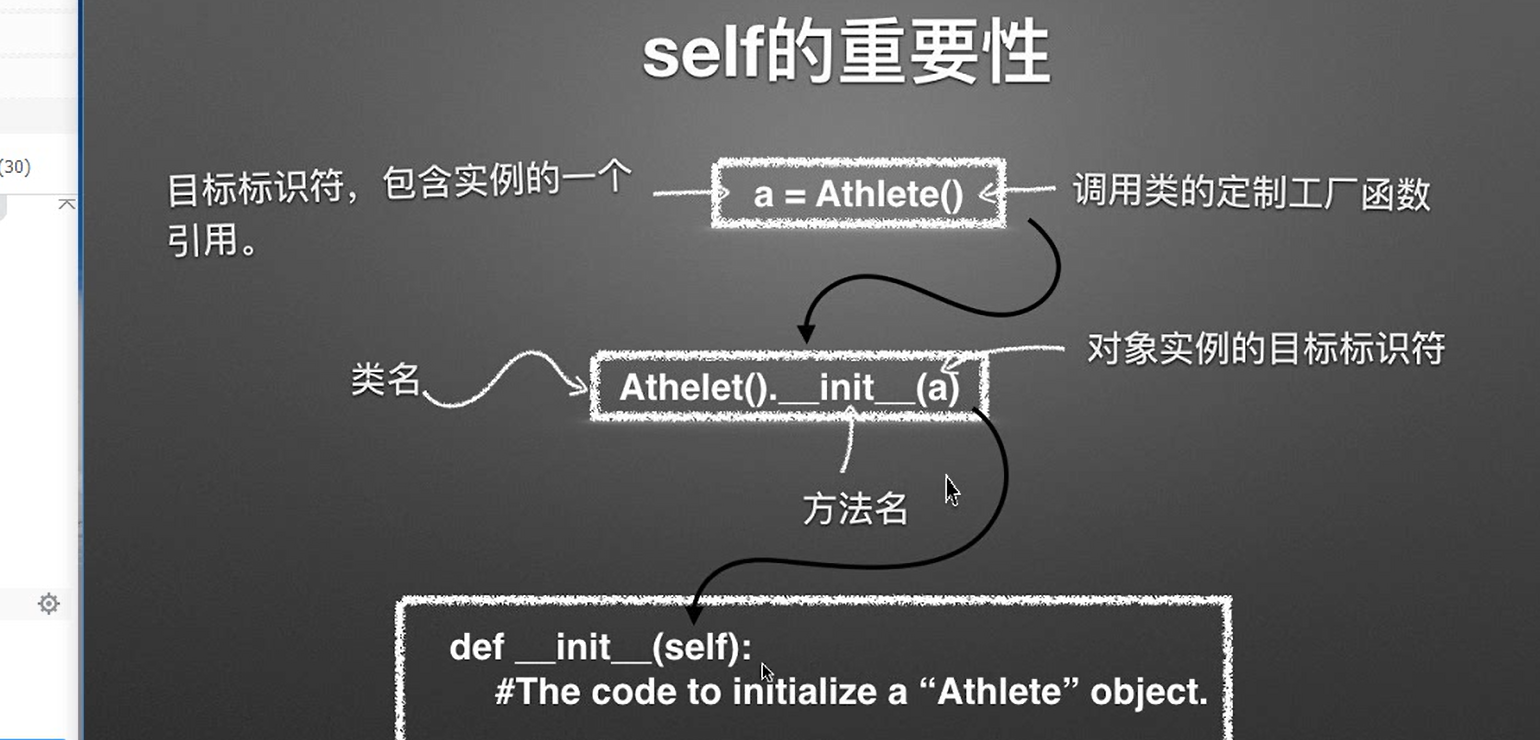
- 针对self如何使用
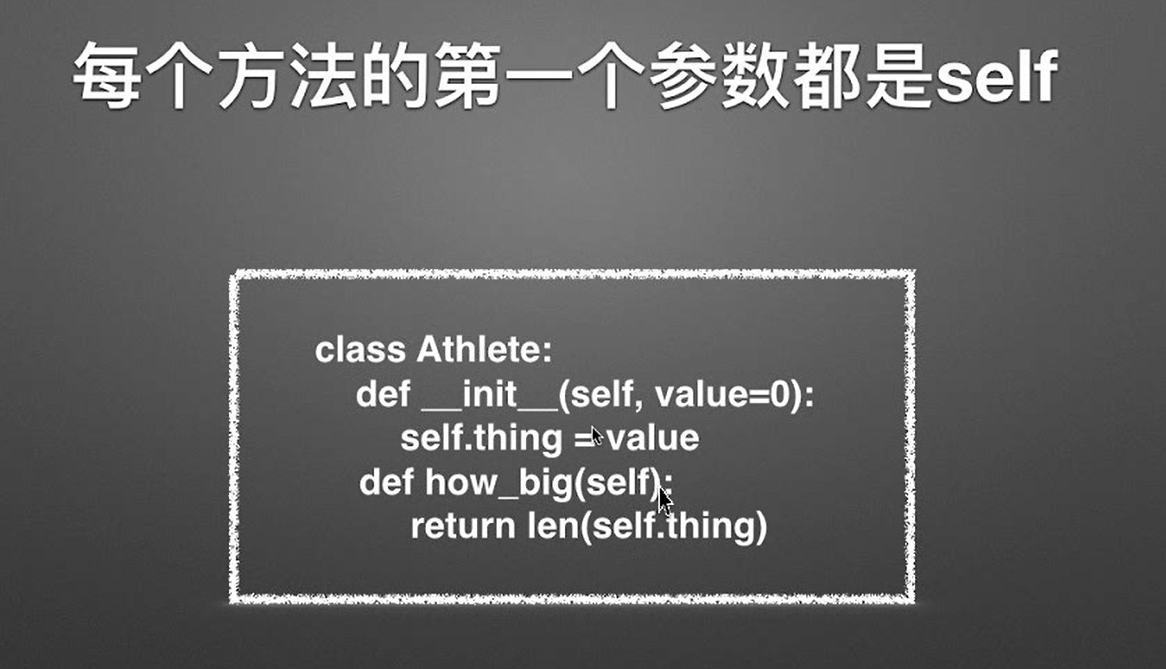
python
class Athelete:
def __init__(self,value=0):
self.thing=value
def how_big(self):
return len(self.thing)
d=Athelete("halo go!!!")
print(d.how_big())
print(d.thing)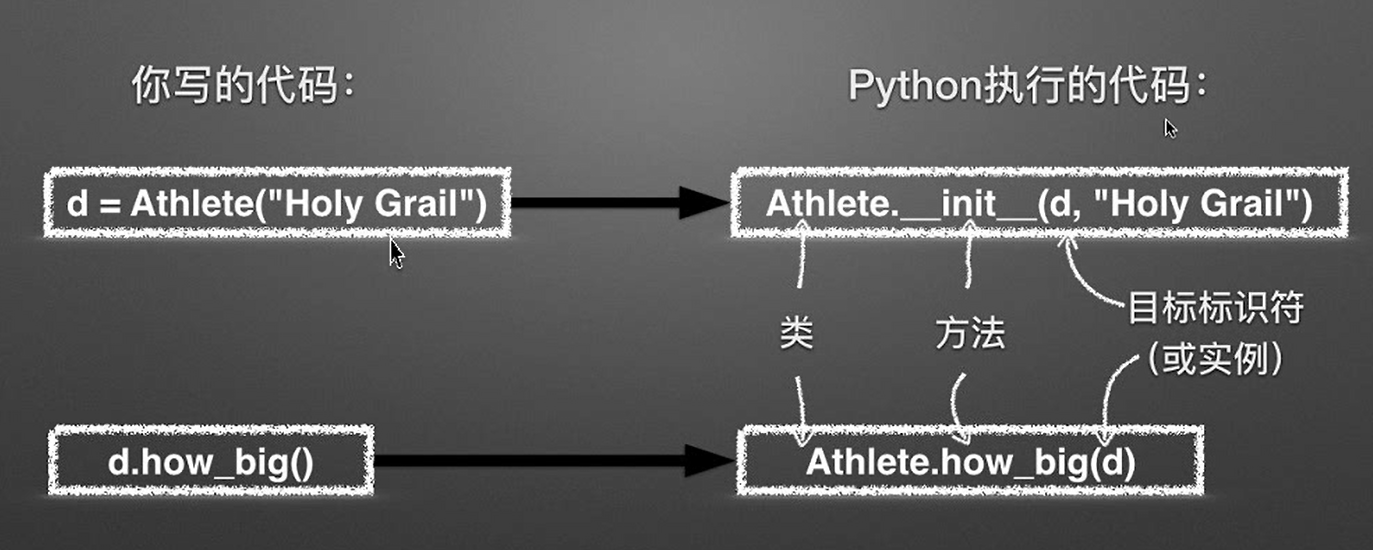
字典和列表类型的转换
python
a={}
lol=[['a','b'],['c','d'],['e','f']]
l=dict(lol)
print(l) ##{'a': 'b', 'c': 'd', 'e': 'f'}字典和元组的转换
python
lot=[('a','b'),('c','d'),('e','f')]
dict(lot) ##{'a': 'b', 'c': 'd', 'e': 'f'}字典和字符串(要求双字符)转换
python
los=['ab','bc','cd','de']
l=dict(los)
print(l) ## {'a': 'b', 'b': 'c', 'c': 'd', 'd': 'e'}字典中元素使用
python
## 往字典中添加元素
d={}
d['l1']=1
print(d) ### {'l1': 1}
d['l2']=2
print(d) ### {'l1': 1, 'l2': 2}
## 修改元素的值
d={}
d={"l1":1,"l2":2}
d.update({"l3":3,"l4":4})
print(d) ##{'l1': 1, 'l2': 2, 'l3': 3, 'l4': 4}
## 删除元素中的值
del d['l4']
print(d) ## {'l1': 1, 'l2': 2, 'l3': 3}
## 判断是否在键值对存在相应的键
print("l1" in d) ## True
## 清空所有元素
d.clear() ## {}
## 获取字典中key和value的情况
print(d.keys()) ## dict_keys(['l1', 'l2', 'l3'])
print(d.values()) ## dict_values([1, 2, 3])
print(list(d.values())) ## [1, 2, 3]
print(d.items()) ## dict_items([('l1', 1), ('l2', 2), ('l3', 3)])
print(list(d.items())) ## [('l1', 1), ('l2', 2), ('l3', 3)]
## 将压缩的列表组合成一个字典
l1=[1,2,3]
l2=['one','two','three']
zipped=zip(l1,l2)
print(dict(zipped)) ## {1: 'one', 2: 'two', 3: 'three'}
## 字典拷贝
d={'l1':1,'l2':2,'l3':3}
d2=d
d.update({'l4':4})
print(d2) ## {'l1': 1, 'l2': 2, 'l3': 3, 'l4': 4}
d={'l1':1,'l2':2,'l3':3}
d2=d.copy()
d.update({'l4':4})
print(d2) ## {'l1': 1, 'l2': 2, 'l3': 3}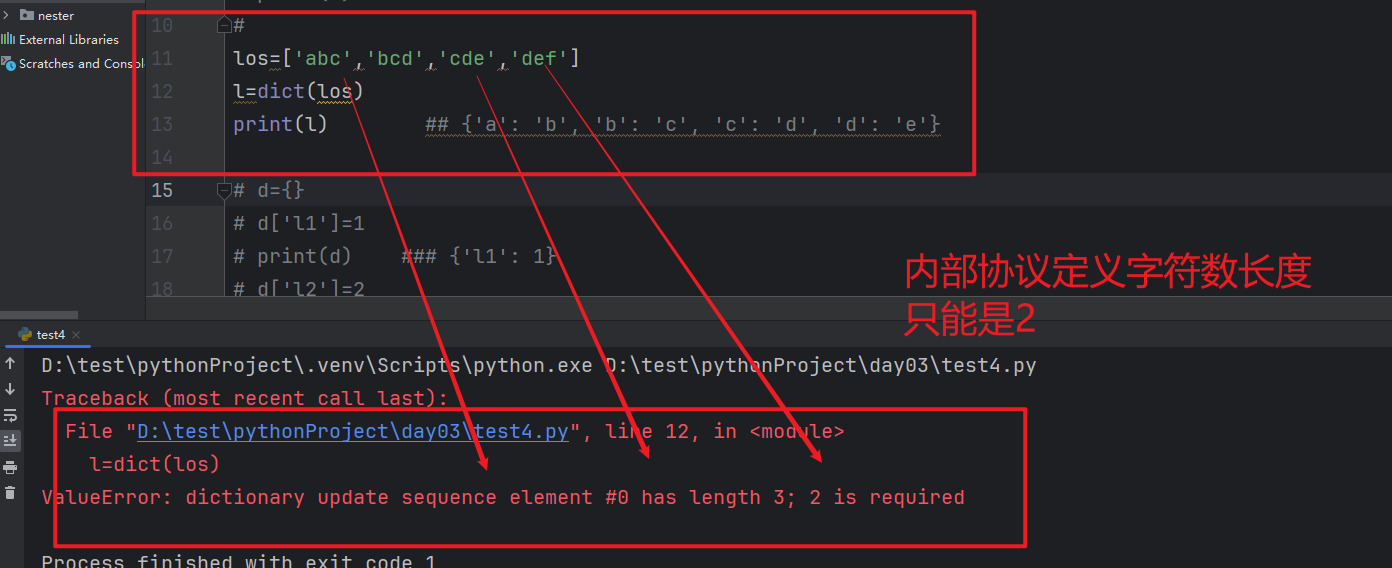
数据类型之集合
set集合的使用(去重)
有关字典和列表的扩充
python
### 推倒单词的个数
word='letters'
letters_counts={letter:word.count(letter) for letter in set(word)}
print(letters_counts)
'''
{'e': 2, 's': 1, 'l': 1, 'r': 1, 't': 2}
'''
## 推倒并判断集合
a_set={1,2,3,4,5,6}
a_set={number for number in range(1,6) if number%2==1}
print(a_set) ''' {1, 3, 5} '''
a_set={1,2,3,4,5,6}
a_set={number for number in range(1,6) if number%3==1}
print(a_set) '''{1, 4}'''数据类型的总结
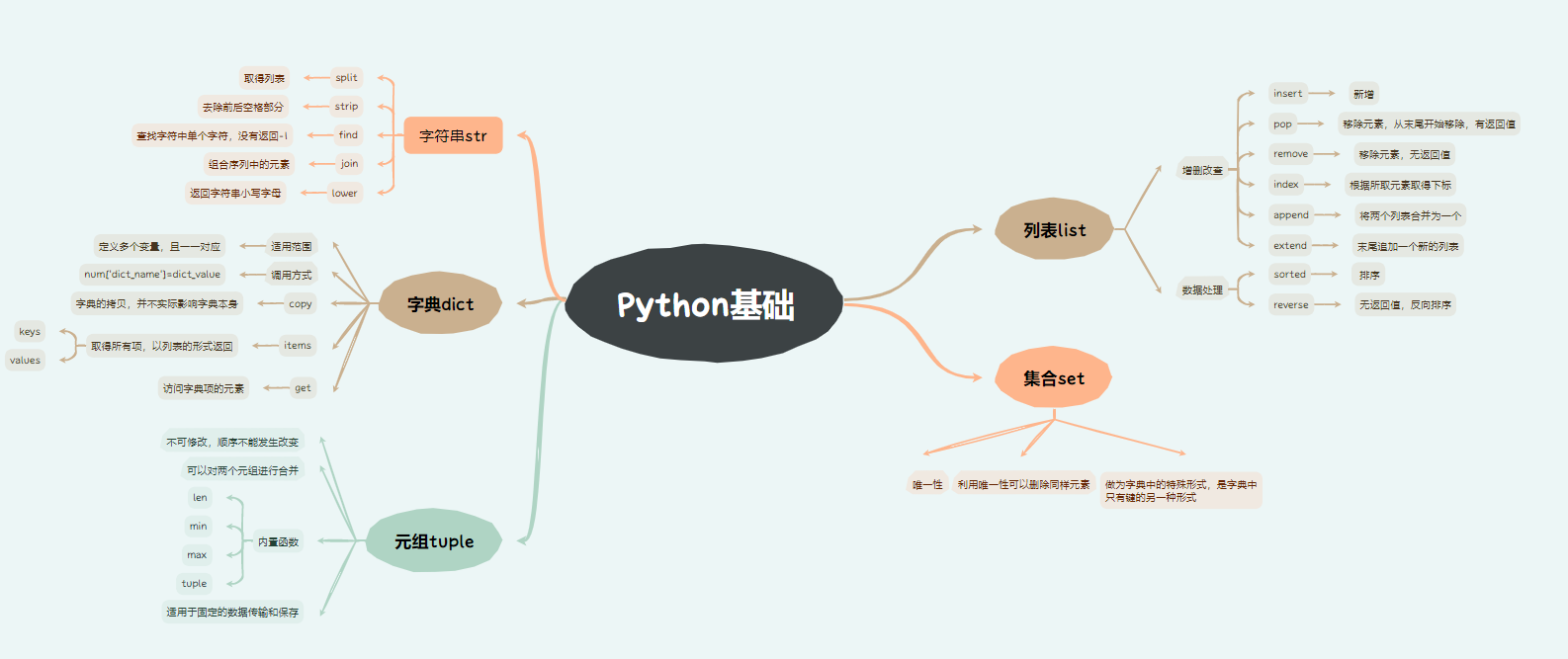
python
## 将列表组合成元组
num=[1,2,3]
name=["l1","l2","l3","l4"]
english=["one","two","three","four","five"]
tol=num,name,english
print(tol) ## ([1, 2, 3], ['l1', 'l2', 'l3', 'l4'], ['one', 'two', 'three', 'four', 'five'])
## 组合成一个统一的列表
tol=[num,name,english]
print(tol) ## [[1, 2, 3], ['l1', 'l2', 'l3', 'l4'], ['one', 'two', 'three', 'four', 'five']]
## 字典的组合
dol={"num":num,"name":name,"english":english}
print(dol) ## {'num': [1, 2, 3], 'name': ['l1', 'l2', 'l3', 'l4'], 'english': ['one', 'two', 'three', 'four', 'five']}
## 复杂数据的获取
house={(44.79,-93.14,285):'my_house',(38.97,-77.04,13):'The white house'}
print(house[44.79,-93.14,285]) ## my_house
## 关于==和is的区别
== 比较值是否相等(比较内存地址),而is则用于比较数据类型
a=1
b=1.0
print(a==b) ## True
print(a is b) ## False
c=1
print(a==c) #True
print(a is c) #True
## 组合打印列表--->元组
cells=[(rows,cols) for rows in row if rows%2==1 for cols in col if cols%2==1]
for cell in cells:
print(cell)
for row,cols in cells:
print(row,cols)面相对象概念及使用
使用对象优化demo,将字典数据转换成对象的形式进行存储
python
class Athelete:
def __init__(self,a_name,a_job=None,a_time=[]):
self.name=a_name
self.job=a_job
self.time=a_time
def top3(self):
return sorted(set([santize(t) for t in self.time]))[0:3]
def santize(time_string):
if '-' in time_string:
spliter='-'
elif ':' in time_string:
spliter=':'
else:
return time_string
minutes,seconds=time_string.split(spliter)
return(minutes+'.'+seconds)
def get_coach_data(filename):
try:
with open(filename) as f:
data = f.readline()
templ=data.strip().split(',')
# return({
# 'name':templ.pop(0),
# 'dob':templ.pop(0),
# 'times':str(sorted(set(santize(t) for t in templ))[0:3])
# })
return (Athelete(templ.pop(0),templ.pop(0),templ))
except IOError as error:
print('File error:'+str(error))
return (None)
james=get_coach_data("james.txt")
print(james.name+"'s faster are:"+str(james.top3()))扩展一个增加时间的版本函数
python
class Athelete:
def __init__(self,a_name,a_job=None,a_time=[]):
self.name=a_name
self.job=a_job
self.time=a_time
def top3(self):
return sorted(set([santize(t) for t in self.time]))[0:3]
### 扩展增加时间API
def add_time(self,time_value):
self.time.append(time_value)
def add_times(self,list_of_times):
self.time.extend(list_of_times)
def santize(time_string):
if '-' in time_string:
spliter='-'
elif ':' in time_string:
spliter=':'
else:
return time_string
minutes,seconds=time_string.split(spliter)
return(minutes+'.'+seconds)
def get_coach_data(filename):
try:
with open(filename) as f:
data = f.readline()
templ=data.strip().split(',')
# return({
# 'name':templ.pop(0),
# 'dob':templ.pop(0),
# 'times':str(sorted(set(santize(t) for t in templ))[0:3])
# })
return (Athelete(templ.pop(0),templ.pop(0),templ))
except IOError as error:
print('File error:'+str(error))
return (None)
# james=get_coach_data("james.txt")
# print(james.name+"'s faster are:"+str(james.top3()))
# james.add_times(['2.22','1-11','3:66'])
# print(james.top3())
varos=Athelete('Vara vi')
varos.add_times(['3.88','1-11','6:88'])
print(varos.top3()) ## ['1.11', '3.88', '6.88']面向对象之继承类
python
class AthleteList(list):
## 属性
def __init__(self,a_dob=None,a_times=[]):
## 初始化父类信息
list.__init__([])
self.name=a_dob
self.times=a_times
self.extend(a_times)
## 方法
def top3(self):
return sorted(set([santize(t) for t in self]))[0:3]
def santize(time_string):
if '-' in time_string:
spliter='-'
elif ':' in time_string:
spliter=':'
else:
return time_string
minutes,seconds=time_string.split(spliter)
return(minutes+'.'+seconds)
def get_coach_data(filename):
try:
with open(filename) as f:
data = f.readline()
templ=data.strip().split(',')
# return({
# 'name':templ.pop(0),
# 'dob':templ.pop(0),
# 'times':str(sorted(set(santize(t) for t in templ))[0:3])
# })
return (AthleteList(templ.pop(0),templ.pop(0),templ))
except IOError as error:
print('File error:'+str(error))
return (None)
# james=get_coach_data("james.txt")
# print(james.name+"'s faster are:"+str(james.top3()))
# james.add_times(['2.22','1-11','3:66'])
# print(james.top3())
## 通过自定义对象提供了对象的可扩展性
varos=AthleteList('Vara vi')
print(varos)
varos.append('1.31')
print(varos.top3())
varos.extend(['2.22','1-21','2:66'])
print(varos) ## ['1.31', '2.22', '1-21', '2:66']
print(varos.top3()) ## ['1.21', '1.31', '2.22']四、面向对象
propetry和attribute方法
python
### 案例实现
### demo1 实现对象的定义和赋值
class Person():
def __init__(self,name):
self.name=name
xm=Person("xiaoming") ## 实例化--->对象
Person.__init__(xm,'xiao ming')
print(type(xm)) ## <class '__main__.Person'>
print(xm.name) ## xiaoming
print(id(xm)) ## 2380080119568
print(hex(id(xm))) ## <class '__main__.Person'>
### demo2 重写一个子类实现父类的方法
class Person():
def __init__(self,name):
self.name=name
def get_name(self):
return self.name
## 这里将父类所继承的方法进行重写
class Man(Person):
def get_name(self):
return "Man"
xm=Person("xiao ming")
print(xm.get_name()) ## xiao ming
xm=Man("xiao ming")
print(xm.get_name()) ## Man
## demo3 针对父类属性进行初始化
class Person():
def __init__(self,name):
self.name=name
def get_name(self):
return self.name
class Man(Person):
## 针对父类属性进行初始化
def __init__(self,name,sex):
Person.__init__(self,name)
self.sex=sex
def get_name(self):
return "Man"
xm=Person("xiao ming")
print(xm.get_name()) ## xiao ming
xm=Man("xiao ming",'boy')
print(xm.name+xm.sex) ## Man
## demo4 子类继承了父类同样拥有父类所包含的方法
class Car():
def exclaim(self):
print("I'm am car!!!!")
class Tesla(Car):
pass
give_me_a_car=Car()
give_me_a_car.exclaim()
give_me_a_Tesla=Tesla()
give_me_a_Tesla.exclaim() ## 子类继承了父类同样拥有父类所包含的方法
##demo5 父类覆盖了父类原有的方法
class Car():
def exclaim(self):
print("I'm am car!!!!")
class Tesla(Car): ## 父类完成了子类的初始化
def exclaim(self):
print("I'm tesla!!")
give_me_a_car=Car()
give_me_a_car.exclaim()
give_me_a_Tesla=Tesla()
give_me_a_Tesla.exclaim()
## 基于父类多种子类方法
class Person():
def __init__(self,name):
self.name=name
class MDPerson(Person):
def __init__(self,name):
self.name="Docker"+name
class JDPerson(Person):
def __init__(self,name):
self.name =name+",Esquire"
person=Person('fudd')
doctor=MDPerson('fudd')
lawyer=JDPerson('fudd')
print(person.name)
print(doctor.name)
print(lawyer.name)
##demo6 实现构造方法的多构建
class car():
def exlaim(self):
print("I'm a car!!!!")
class Tesla():
def exlaim(self):
print('I am a tesla')
def need_a_push(self):
print('A little help here?')
give_me_a_car=car()
give_me_a_car.exlaim()
give_me_a_tesala=Tesla()
give_me_a_tesala.need_a_push()super调用
使用super方法可以让子类调用父类的方法
python
class Person:
def __init__(self,name):
self.name=name
class EmailPetrson(Person):
def __init__(self,name,email):
super().__init__(name) ## 子类调用父类方法,父类的方法已经被子类所引用
self.email=email
bob=EmailPetrson('bob','bob@163.com')
print(bob.name,bob.email)对getter和setter属性进行隐藏(封装)
python
class Duck():
def __init__(self,input_name):
self.hide_name=input_name
def get_name(self):
print('inside getter')
return self.hide_name
def set_name(self,input_name):
print('insider setter')
self.hide_name=input_name
name=property(get_name,set_name) ## 通过字段将getter和setter内容进行隐藏
fowl=Duck('hallo')
## 同过此特性隐藏了对象中的内容(装饰器)
print(fowl.name)
fowl.name=('hllll')
fowl.set_name('6666')
print(fowl.name)
# ## 通过getter也可调用内部方法
# print(fowl.get_name())
#
# fowl.hide_name='ooookkkkk'
# print(fowl.hide_name)装饰器的使用
@classmethod和@property使用
python
## property装饰器的用法
## demo1
class Duck():
def __init__(self,input_name):
self.hide_name=input_name
@property
def name(self): ## 函数名发生修改
print('inside getter')
return self.hide_name
@name.setter
def name(self,input_name): ## 函数名发生修改
print('insider setter')
self.hide_name=input_name
# name=property(get_name,set_name) ## 通过字段将getter和setter内容进行隐藏
fowl=Duck('hallo')
## 同过此特性隐藏了对象中的内容
print(fowl.name)
fowl.name=('hllll')
print(fowl.name)
## demo2
class Circle():
def __init__(self,radius):
self.radius = radius
@property
def diameter(self):
return 2*self.radius
c=Circle(5)
print(c.diameter) ## 10
c.radius=7
print(c.diameter) ## 14
## demo3
class Duck():
def __init__(self, input_name):
self.__name = input_name
@property
def name(self):
print('inside the getter')
return self.__name
@name.setter
def name(self,input_name):
print('inside the setter')
self.__name = input_name
fowl=Duck('hallo')
print(fowl.name)
fowl.name='Hooc'
print(fowl.name)
## demo4 @classmethod
class A():
## 这里的count是类全局的变量
count=0
def __init__(self):
A.count+=1
def exclaim(self):
print('I am an A!!!')
@classmethod
def kids(cls):
print('A has',cls.count)
num_A=A()
buzzsy_A=A()
whezzy_a=A()
A.kids()@staticmethod使用
定义之后的方法不需要传递参数(self,cls)
python
### staticmethod
class A:
@staticmethod
def a():
print('I AM GOOD')
A=A.a()
## instance method,class method,static method
class A:
count=0
def __init__(self):
A. count+=1
def exclaim(self):
print('I AM an A')
@classmethod
def kids(cls):
print('A has',cls.count)
@staticmethod
def a():
print('我是A')
a=A()
## 类方法
A.kids()
A.exclaim()
## 实例化方法
a.kids()
a.exclaim()多态练习使用
python
## 鸭子类型
class Quote():
def __init__(self,person,words):
self.person = person
self.words = words
def who(self):
return self.person
def says(self):
return self.words+'.'
class QuestionQuote(Quote):
def says(self):
return self.words+'?'
class ExclamationQuote(Quote):
def says(self):
return self.words+'!'
class BabblingBrook():
def who(self):
return 'Brook'
def says(self):
return 'Babble'
brook=BabblingBrook()
def who_says(obj):
print(obj.who(),'says',obj.says())
who_says(brook)
hunter=Quote('Elmer Fudd',"I'm a good day")
# print(hunter.who(),'says:',hunter.says())
#
hunter1=QuestionQuote('Bus Bunny',"what's up,doc")
who_says(hunter1)
# print(hunter1.who(),'says:',hunter1.says())
hunter2=ExclamationQuote('Daffy Ducks',"it's rabbit season")
who_says(hunter2)
# print(hunter2.who(),'says:',hunter2.says())常见的魔术方法使用
python
class world:
def __init__(self,text):
self.text=text
def equals(self,word2):
return self.text.lower()==word2.text.lower()
first=world('hai')
second=world('HAI')
third=world('llo')
print(first.equals(second)) ## True
print(second.equals(third)) ## False
class word():
def __init__(self,text):
self.text=text
def __eq__(self, word2):
return self.text.lower()==word2.text.lower()
first=word('ha') ## True
second=word('HA') ## False
third=word('LO')常见的魔术方法(见如下魔术方法)
python
class word():
def __init__(self,text):
self.text=text
def __eq__(self, word2):
return self.text.lower()==word2.text.lower()
def __str__(self):
return self.text
def __repr__(self):
return 'Word('+self.text+')'
first=word('ha') ### first结果是word(ha)
print(first) ### ha 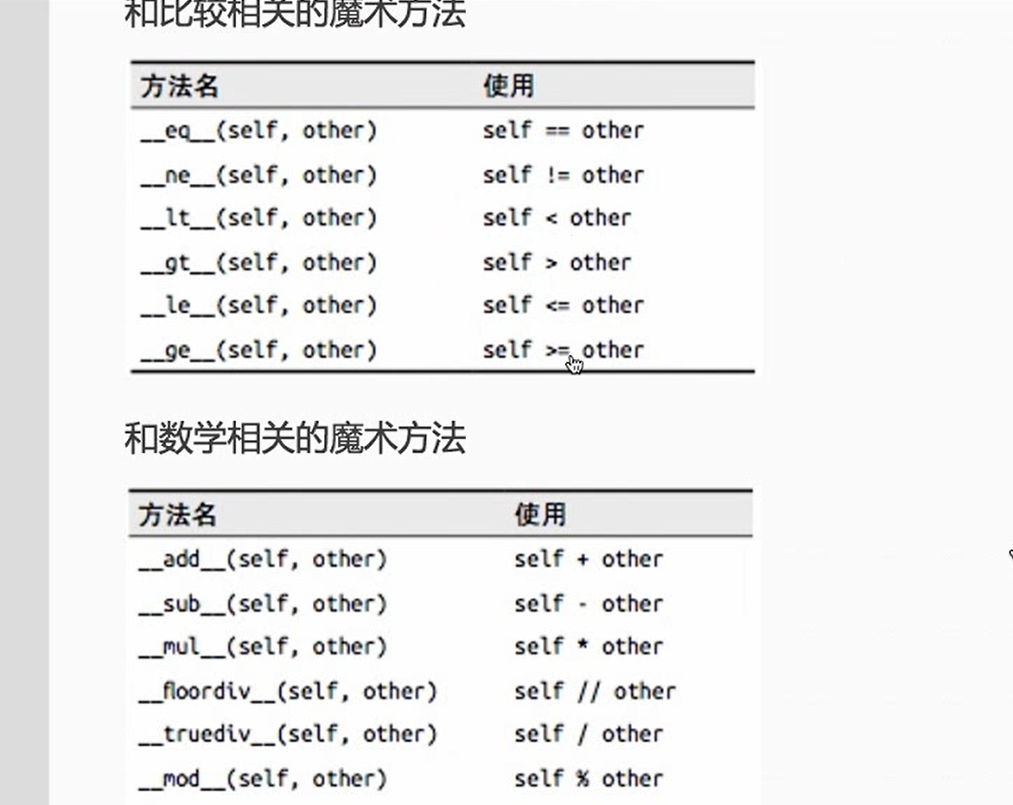

对象的组合使用
python
### 类与类之间不存在继承关系,而是彼此互相组合在一起
class Tail():
def __init__(self,length):
self.length = length
class Bill():
def __init__(self,description):
self.description =description
class Duck():
def __init__(self,bill,tail):
self.bill = bill
self.tail = tail
def about(self):
print('The duck has a',self.bill.description,'bill and a',self.tail.length,'tail')
tail=Tail('long')
bill=Bill('orange')
duck=Duck(bill,tail)
duck.about() ## The duck has a orange bill and a long tail五、综合练习
python
验证一个文本里面的密码,如果正确返回,不正确重试3次,添加注册(用户名和密码)登录流程
密码文件使用pickle标准库保存
python
import pickle
import getpass
## 读取文件内容
def open_database():
try:
with open('passwd.pkl', 'rb') as f:
return pickle.load(f)
except IOError as error:
return False
except Exception as e:
raise False
## 更新文本内容
def update_database(user_data):
try:
with open('passwd.pkl','wb') as f:
pickle.dump(user_data,f)
return True
except IOError as error:
return False
except Exception as e:
raise False
## 注册
def register():
## 输入用户名和密码
username=input('请输入用户名:')
## {"username":"passwd"}
user_data=open_database() if open_database() else {}
if username in user_data.keys():
print('用户已经存在')
return False
userpasswd=input("请输入密码:")
user_data[username]=userpasswd
db_status=update_database(user_data)
if not db_status:
print('注册失败!')
print('注册成功')
## 登录
def login():
count=0
username = input('请输入用户名:')
while count<3:
userpasswd=input("请输入密码:")
# userpasswd = getpass.getpass("请输入密码:") ## 隐藏密码
user_data=open_database()
passwd=user_data.get(username)
if passwd is None:
print('用户不存在!')
break
if userpasswd!=passwd:
count+=1
print('密码错误!,请重试,最多3次')
continue
print('密码正确!')
break
else:
print('已经重试了3次,退出!')
## 入口
def main():
while True:
user_choice=input("1.注册 2.登录 0.退出")
if user_choice=="1":
register()
elif user_choice=="2":
login()
else:
break
if __name__ == '__main__':
main()